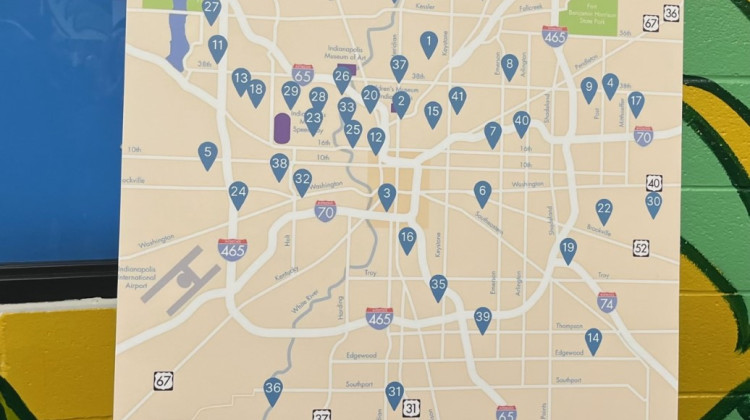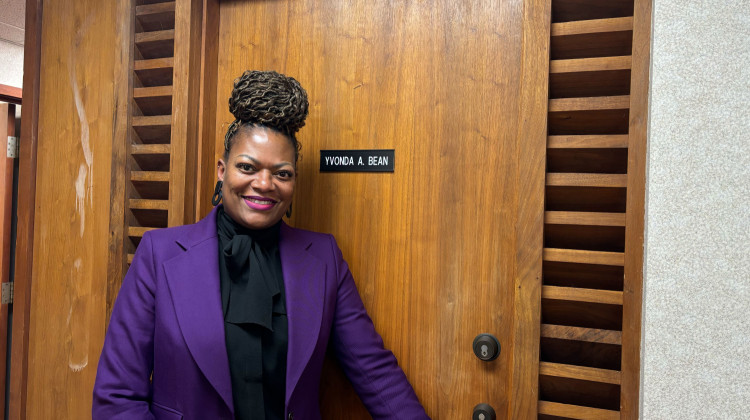How does a rough neighborhood turn a corner? And when? As part of the Neighborhood Project, reporter Andrea Muraskin spent time in the Near Westside. She found that, when it comes to public safety, perception is powerful.
When Leigh McCall moved to the Near Westside 30 years back, it was a big change from where she used to live in Beech Grove.
"When we first moved in I remember feeling very fortunate, because we were the only ones who had a muffler on their car," she said.
Over the years she’s seen drug dealing, prostitutes, couples fighting in the street, and trucks full of garbage getting dumped in the alleys.
Today, McCall is president of the association for the We Care neighborhood. She says the near west still has its struggles, but things have gotten better in the last five years.
"We have a large police presence, which helps so much. They come to my meetings once a month. We have personal relationships with them. I can call them if I need them," she said.
But Leigh doesn’t just credit the police for the change. For example, she says the monthly cleanups that she helps organize have made a big difference.
"I think it makes people feel better. They feel like there's a better quality of life, and I think if you get the trash out, the drugs and prostitution go with it," she said.
Armando Morales has lived in the Hawthorne neighborhood for about 10 years. If you walk the alley between his house on Mount Street and Hawthorne Park, a recent addition: every garage door on the block has been painted with a brightly-colored mural.
The murals were painted by teens last year as part of an IUPUI summer employment program. Morales said that before the garages where painted, he saw evidence of gang activity behind his house.
"We saw their logos that they would put, you know, East Side, West Side, those sorts of things," he said.
Since the murals went up, armando hasn’t seen any more gang tags, and that’s contributed to his sense of safety.
"I think it's gotten a little bit safer. What I've seen is we as a community have gotten together more, so the gangs can't paint their signs, and make their big mess out on the garage," he said.
According to data from the IMPD for the four westside neighborhoods of We Care, Hawthorne, Haughville and Stringtown, property crimes have decreased slightly: from 1,062 in 2011 to 1,039 in 2013. But violent crime went up in the same time period: from 283 incidents in 2011 to 355 in 2013.
David Hoffman is IMPD commander of the Southwest District, which includes the near west. He acknowledges there’s lots of work to be done to bring down crime here. But to him, a reduction in the fear of crime is an achievement in itself.
"Reality does drive perception, and vice versa. Perception drives reality," Hoffman said. "So if a neighborhood is viewed as 'That's a place you don't wanna go to,' then people won't go there. They won't spend money there, they won't purchase real estate, they won't decide that that is the place they want to live. And what will happen is, a neighborhood will die on the vine."
But turn a community into a place people want to live? That reduces crime.
"However we do it, however we get to the crime reduction and keeping people safe, then that's what we're interested in doing, and we're exploring a lot of different and non-traditional activities that the police department didn't have a lot of input in," he said.
Lt. Susan Hill is elbow-deep in non-traditional activities. Her title is Crime Strategist, but to talk to her, she sounds more like a community organizer. She says the police got involved about three years ago with the Reconnecting Our Waterways initative, and built on from there.
"We took positions on the steering committee and White River Waterway Committee, which helped us form partnerships with the Near West Collaborative, with other for-profit and non-profit groups such as Goodwill, the school systems and businesses around the Near West," Hill said.
She spends a lot of time working with different groups to apply for grants - to pay for things like lighting in streets and alleys.
And Hoffman says the community reciprocates by helping them with their police work.
"It’s really amazing that we may have a pastor who can gather information about the goings on in the neighborhood, probably more effectively than a cop in a police car," he said.
Teens at The Underground, a youth program affiliated with the West Morris Street Methodist Church, have a different take on the direction the area is headed.
"It's not getting better, it's actually getting worse," said Brie, a 10th grader who lives in Haughville. "When I stand on my front porch I see cops, ambulance, and people running. I can't walk down the street without a knife or a weapon on me."
Chase, also a 10th grader, lives in Hawthorne. He says he has noticed the efforts to clean up the neighborhood. But he also sees gangs all around, especially a gang called “West Side Little Mex.”
"Westside Little Mex, they're tagging all the garages, all the murals that the Near West, like Hawthorne and We Care have been painting around the neighborhoods," Chase said. "They don’t care what they do anymore."
When told that activists like Leigh McCall think the neighborhood is improving, partially because of the close relationship they’ve built with the police, Chase said that the neighborhood needs better connection with "youth in the neighborhood that is causing all the chaos."
"They need to have the kids more involved in community service and everything, and getting them to just not be out running the streets," he said.
Leigh McCall said the near west neighborhoods do try to engage kids, from Easter egg hunts to parties for teenagers.
Still, it’s hit or miss, she said.
"I did a free lunch program," McCall said. "I chose to discontinue it after two weeks because I was getting thirty lunches a day, and I never had more than eight kids to eat."
She thinks if parents were more involved, kids would be more likely to participate in activities, and less likely to walk the street or join gangs.
McCall also said she’s also not had much success getting Hispanic residents involved.
There’s room for improvement, she said. She believes the community is close knit, and she thinks that neighbors are "working at working together."
 DONATE
DONATE







 View More Articles
View More Articles



 Support WFYI. We can't do it without you.
Support WFYI. We can't do it without you.